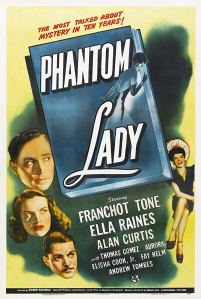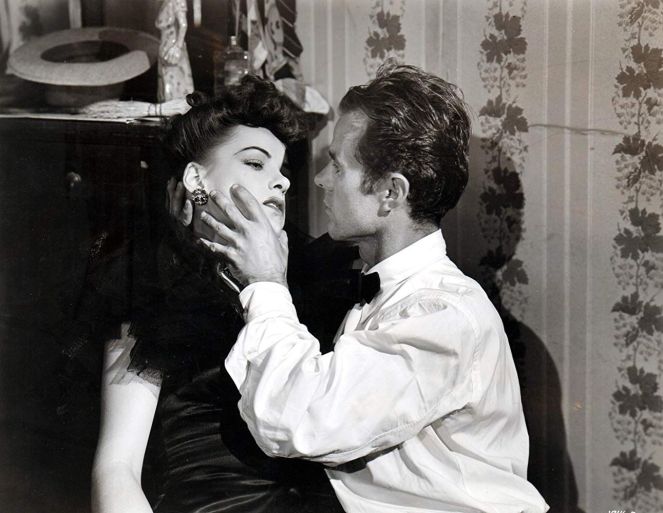
After a spat with the wife, civil engineer Scott Henderson (Alan Curtis) decides to have a little gin with his misery and bellies up to the bar in a dive called Anselmo’s. He makes the acquaintance of a mysterious woman wearing a rather distinctive hat…and seeing that she’s just as despondent as he is, asks her if she’d be interested in accompanying him to the show that Mrs. Henderson put the kibosh on. The two of them go out and have a grand time; Scott never learns the mystery lady’s name (she insisted that she remain anonymous and that they keep everything on the QT)…and that’s going to pose a problem. Upon returning to his apartment, he’s informed by a cop named Burgess (Thomas Gomez) and his associates (Regis Toomey, Joseph Crehan) that Mrs. H is really most sincerely dead. Strangled, that is. With one of Scott’s neckties—”knotted so tight, it had to be cut loose with a knife.”

We’ve been involved with this movie from the beginning. We know that Scott had a date with the “phantom lady” of the film’s title, so we also know he’s no stone–cold killer. The dilemma is: he can’t get anyone to back up his story. The bartender (Andrew Tombes) at the watering hole where the couple’s adventure started remembers Henderson…but the lady in the crazy hat? He can’t recall. Same goes for the cab driver (Matt McHugh) who took them to the theatre and a drummer (Elisha Cook, Jr.) who couldn’t help but ogle the dame-with-the-millinery throughout the performance. The star of the show (Aurora) certainly spotted the woman because the two of them were wearing the same chapeau! But it’s a sensitive subject where she’s concerned, so the chanteuse tells the cops she doesn’t remember, either.
Henderson is tried and convicted for murder…and unless his loyal secretary Carol Richman (Ella Raines) can locate his enigmatic companion from that fateful evening, he’s soon going to get a visit from a priest telling him: “Scott, it’s time…”
 We owe a debt to prolific mystery writer Cornell Woolrich as much as anybody for the cinematic style we know as film noir. Woolrich’s novels and short stories were adapted to make many “dark city” movies (not to mention radio and TV shows) like The Mark of the Whistler (1944; “Dormant Account”), Fear in the Night (1947; “Nightmare”), The Window (1949; “The Boy Who Cried Murder”), and No Man of Her Own (1950; “I Married a Dead Man’). The classic Hitchcock film Rear Window (1954)? It, too, is based on a Woolrich story (“It Had to Be Murder”), one that he wrote under the Woolrich name. Many of the author’s works were published as “William Irish” including the 1942 novel The Phantom Lady, which was adapted for this film by Bernard C. Schoenfeld (whose other noir screenplays include The Dark Corner [1946] and Down Three Dark Streets [1954]).
We owe a debt to prolific mystery writer Cornell Woolrich as much as anybody for the cinematic style we know as film noir. Woolrich’s novels and short stories were adapted to make many “dark city” movies (not to mention radio and TV shows) like The Mark of the Whistler (1944; “Dormant Account”), Fear in the Night (1947; “Nightmare”), The Window (1949; “The Boy Who Cried Murder”), and No Man of Her Own (1950; “I Married a Dead Man’). The classic Hitchcock film Rear Window (1954)? It, too, is based on a Woolrich story (“It Had to Be Murder”), one that he wrote under the Woolrich name. Many of the author’s works were published as “William Irish” including the 1942 novel The Phantom Lady, which was adapted for this film by Bernard C. Schoenfeld (whose other noir screenplays include The Dark Corner [1946] and Down Three Dark Streets [1954]).

Phantom Lady (1944), it could be argued, was the first important film for German émigré Robert Siodmak—who made his name helming Universal programmers like Fly-by-Night (1942) and Son of Dracula (1943) before becoming one of noir’s most important directors with contributions like The Killers (1946) and Criss Cross (1949). I realize that it will be hard for me not to gush—I’m simply mahd about Bob—but Phantom Lady is an amazing exercise in Siodmak’s distinctive style, putting the lessons he learned in German expressionist cinema to use with an absolute mastery of light and shadow. So many sequences stand out in this film: my favorite is the lengthy scene where Ella Raines’ secretary stalks Andrew Tombes’ bartender through the streets as Tombes walks home (the echoes of their footsteps the only punctuation in the scene), following him to a foreboding elevated train platform.

Lady was also the debut film for Joan Harrison, one of the few female studio execs at that time; she began her career in the picture business as secretary to The Master of Suspense before eventually contributing to screenplays of Hitchcock classics like Foreign Correspondent (1940) and Saboteur (1942). Following the success of Lady, Joan later went on to produce noirs such as The Strange Affair of Uncle Harry (1945) and They Won’t Believe Me (1947), and would eventually work on Alfred Hitchcock Presents and The Alfred Hitchcock Hour on the small screen. Fittingly, Phantom Lady sports a most familiar Hitchcockian theme: that of the “wrong man” who must be exonerated by someone close to him (in this case, Henderson’s secretary…who’s got it bad for her boss even though he’s oblivious to her infatuation [he jokingly calls her “Kansas”]).

Because Alan Curtis spends a large amount of Phantom Lady’s screen time wondering when the state is going to offer him The Chair (since they don’t have a davenport), Raines is assisted in her quest to clear her boss’ name by Thomas Gomez, who’s quite good as the cop who eventually becomes convinced that Curtis is the victim of a miscarriage of justice (he believes a guilty man would have concocted a better story than Curtis’ shaky alibi), and Franchot Tone—a friend of Curtis’ who bummed around South America while the trial went on. Tone’s the big name in the film (he gets top billing despite not making an appearance until 45 minutes in) but Phantom Lady is really a movie that should be seen for its supporting cast in Raines, Gomez, and Elisha Cook, Jr—he figures in the film’s other memorable sequence in which he’s seen being brought to climax by a frenzied drum solo (a few sources credit Cook’s drumming to the legendary Buddy Rich…but it’s really the work of Dave Colman). If you’re a sharp-eared listener, you can make out the voices of Samuel S. Hinds (as the trial judge) and Milburn “Doc” Stone (as the D.A.); I always get a kick out of spotting faces like OTR veterans Jay Novello (as “Anselmo,” the bar’s owner) and Lillian “Birdie” Randolph (she’s on the “el” platform).
 Before Universal (in tandem with The Greatest Cable Channel Known to Mankind™) released Phantom Lady to MOD DVD in the fall of 2014, it was a hard movie to track down (I first saw it on the AMC Film Noir Preservation Festival [bows head out of respect for its demise] and later bought a Region 2 copy [released in 2007]). But the search is hereby over: Arrow Academy (“The Criterion of cult”) made it a Blu-ray debutante on March 12 of this year, with an HD presentation transferred from the original film elements. The disc also includes an image gallery and a documentary, Dark and Deadly: 50 Years of Film Noir, which bridges the worlds of noir and neo-noir by interviewing veterans like Robert Wise and John Alton and newcomers like John Dahl (The Last Seduction) and Carl Franklin (One False Move). For old-time radio fans, there’s the presentation of Lady on The Lux Radio Theatre from March 27, 1944 with Curtis and Raines reprising their film roles (Brian Aherne fills in for Franchot Tone). I highly recommend this purchase, and many thanks to Clint Weiler of MVD Entertainment for shooting the screener my way.
Before Universal (in tandem with The Greatest Cable Channel Known to Mankind™) released Phantom Lady to MOD DVD in the fall of 2014, it was a hard movie to track down (I first saw it on the AMC Film Noir Preservation Festival [bows head out of respect for its demise] and later bought a Region 2 copy [released in 2007]). But the search is hereby over: Arrow Academy (“The Criterion of cult”) made it a Blu-ray debutante on March 12 of this year, with an HD presentation transferred from the original film elements. The disc also includes an image gallery and a documentary, Dark and Deadly: 50 Years of Film Noir, which bridges the worlds of noir and neo-noir by interviewing veterans like Robert Wise and John Alton and newcomers like John Dahl (The Last Seduction) and Carl Franklin (One False Move). For old-time radio fans, there’s the presentation of Lady on The Lux Radio Theatre from March 27, 1944 with Curtis and Raines reprising their film roles (Brian Aherne fills in for Franchot Tone). I highly recommend this purchase, and many thanks to Clint Weiler of MVD Entertainment for shooting the screener my way.

This sounds like something destined for the movie shelf.
My daughter’s reaction to the drum solo sequence: “Eww.”
LikeLiked by 1 person
Siodmak creates some knockout visuals once Carol takes to roaming the city’s darkened streets to find the killer. The scene in which she follows the suspicious bartender is a tour-de-force as the two move through rainy streets, a shadow-filled train platform, and partially lit arches. It as good as the famous sequence in CAT PEOPLE (1942) in which Jane Randolph is followed by something after leaving the swimming pool. Speaking of Lewton’s movies, a Woolrich story was also the basis for THE LEOPARD MAN, a personal favorite.
LikeLiked by 1 person
And I love how there’s nothing but the sound of footsteps throughout this whole piece. I think Hitchcock once referred to it as “pure cinema” (he’s got a similar sequence in TORN CURTAIN, as Paul Newman attempts to evade his “handler” in the museum).
LikeLike
I love that movie, wrote about it about a year ago. Siodmak must be every Noir fan’s favorite and the visuals here are stunning. Ella Raines is dynamite. That drum solo though…I can’t believe the PCA let that slide. They were probably asleep, thankfully, as they so often were.
LikeLiked by 1 person
Yeah, I can’t help but gush on Siodmak. His visual style is simply intoxicating.
LikeLike